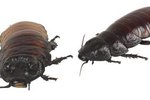Crickets don't actually hear with their legs; they hear with tiny ears located on their legs, and they aren't the only insects with ears on their legs. Grasshoppers, katydids and locusts have them too. Crickets, grasshoppers, katydids and locusts comprise the order Orthoptera. Orthopterans are straight-winged insects with ears located on their front legs just below the knee. Orthopteran ears are some of the smallest in the animal kingdom.
How a Cricket's Ears Work
The ears of crickets and all orthopterans work the same way human ears work. They are sensitive to sound waves created by vibrations. Once a cricket's ear has captured the sound waves, it converts and amplifies them, and then analyses their frequencies. A cricket can tell where a sound is coming from by changing the direction it is facing.
Parts of a Cricket's Ear
While all orthopterans, including crickets, have eardrums, research by entomologist Dr. Fernando Montealegre-Z of the University of Lincoln in Lincolnshire, United Kingdom, shows that bushcricket and perhaps other orthopteran ears have a structure that human ears don't have. The novel structure, which Dr. Montealegre-Z named the auditory vesicle, analyses sound frequencies and is similar to the human cochlea, but it is uncoiled and filled with fluid. The process works through a tympanal lever system that acts similarly to human ossicles to convert and amplify sound wave vibrations.
How Crickets Communicate
Male crickets have two structures on their wings that allow them to produce sound: a file and a scraper. When the file and scraper are rubbed against each other in a process called stridulation, they make a chirping sound. Only male crickets chirp. They chirp different types of songs to communicate with male and female crickets. Male crickets have a song to attract females to their location, a song for females that are nearby and a post-mating song. They also have a song of aggression to warn other males to stay out of their territory and a song warning males and females when danger is near.
Fun Fact
Crickets chirp more frequently in warmer weather, so you can estimate the temperature by counting cricket chirps. Count the number of chirps a cricket makes in 15 seconds and add 37 to that number. For example, if you count 40 chirps in 15 seconds, the temperature will be approximately 77 degrees Fahrenheit.
References
- Ohio Governor’s Residence and Heritage Garden: Why do Crickets
- Great Plains Nature Center: Field Cricket
- Everyday Mysteries from the Library of Congress: Can you tell the temperature by listening to the chirping of a cricket?
- sciencemag.org: Convergent Evolution Between Insect and Mammalian Audition
- University of Florida Department of Entomology: Stridulatory File Teeth in Crickets: Taxonomic and Acoustic Implications
Writer Bio
Laura Payne has been freelance writing for several online publications in her free time since 2006. She holds a Master of Arts in linguistics from Wayne State University and a Bachelor of Arts in journalism from Oakland University. Payne teaches linguistics classes at both universities on an adjunct basis.





